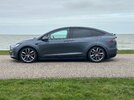ChapterBook7
Member
I am in the process of putting 20"s on to my X. Its cheaper than you think especially when you consider the resale value of the 22's. With a little patience you could buy oem 20's wheels for ~$500. The 22's are worth about $1,500I'm in Europe, so some of these questions are location-specific, so any opinions, especially from those driving a MX in Europe would be appreciated.
Have been driving an MY for 15 months and now getting a second MX. I am wondering which one of these upgrades are worth the money:
1. CCS charging - does it actually speed up charging, or just enables charging at Tesla v3 only locations and 3rd party CCS chargers, but charges at the same speed as the original charge port?
2. FSD and/or HW3 - car currently has HW2.5 and EAP. In my MY (which I bought with FSD), in Europe, I consider FSD a waste of money as we don't get pretty much anything else (that actually works anyway) than what's already included in EAP. But there is one thing I'm missing in the MX that I have in the MY: the additional things the computer detects (mainly traffic lights, speed limits, etc.) and the functionality this provides (stopping at traffic lights, green light chime, which I understand is only available with HW3). So my initial idea is to only upgrade the hardware to HW3 (I think it's about EUR 1000) and stay with the EAP, which does these things. The only consideration is that as far as I understand, the upgrade to FSD (about 3600 EUR) already includes the HW3 upgrade without extra charge, making the difference only about EUR 2600. But if I pay for the HW3 upgrade alone, and later decide to upgrade to FSD for whatever reason, I assume it will still be the same cost so I would lose EUR 1000. The main question is, could the FSD upgrade potentially increase the resell value of the car (I intend to keep it for 1-3 years, then switch to a newer model) so that it's worth the additional EUR 2600?
Also, do I understand correctly that if I keep HW2.5 then the car will keep using the ultrasonic sensors i.e. no full switch to Tesla Vision only, which would then disable them? ATM, I don't know if that's a good thing or a bad thing, I just can't tell how Tesla Vision can detect something like the back wall of my dark garage, which the USS picks up with absolute accuracy - how does Tesla Vision see in the dark with cameras only? Also there are frequent constructions on German freeways with very narrow temporary lanes where the USS can clearly "see" that there is a barrier very, very close to the side of the car, and even a few cm/inches could make the difference of staying clear of it (which the USS enabled car is clearly capable of) and the possibility of a camera based system not being able to detect the distance of random objects like a steel barrier with such accuracy, and the consequences.
3. The car I bought comes with 22 inch wheels. While they look cool, I understand that the 20 inch wheels provide a softer and quieter ride, and I don't buy cars for a "cool look", rather for comfort (long road trips, etc.). Would "downgrading" (actually an upgrade IMO) to 20 inch wheels improve the ride quality enough to worth the trouble? Has anyone driven both and felt a significant difference in ride quality?
Any input and opinions are appreciated!
I found the 22's tax the stated range. This certainly becomes evident when you drive with a little spirit.
Over the next few weeks I am going to be buying iON evo's which is said to increase range by %6 and decrease road noise
With a combo of the 20's + Ev tires I am hoping for an increase in range on the order of 18-20% which would be huge.
GL and keep us posted.





